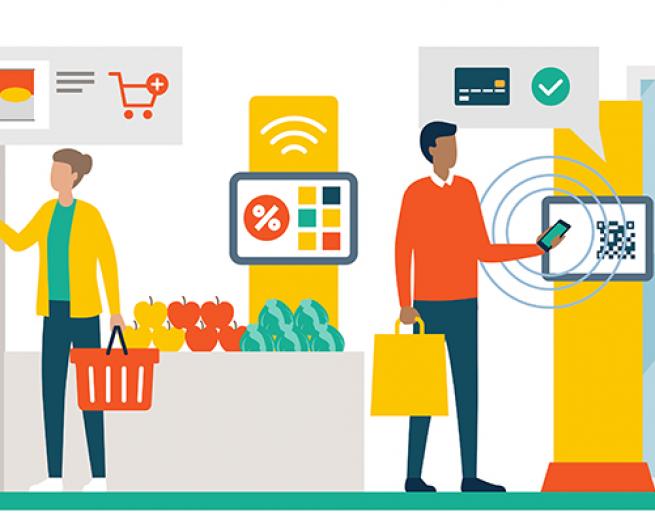
We’re all used to static supermarket shelves. Forward-looking retailers are enhancing the old analog shelf with digital features, turning them into smart shelves that benefit both consumers and retailers.
Power delivery to these shelves has been a problem that delayed their adoption, but new wireless power technology now exists to solve this problem and make these shelves smart.
The benefits for supermarket retailers
Smart digitally enhanced shelves provide retailers with new visibility and control. By automatically tracking in-store inventory levels, the retailer can enhance inventory management and make smarter restocking decisions. Tracking the presence of items on the shelves also reduces theft and shrinkage.
When smart shelves are equipped with electronic price tags, retailers can easily update the price to reflect short-term promotions, match a competitor’s price or help move low-selling items. When sensors can monitor the shopping behavior of customers, merchandising the store layout can be optimized based on real-time data, and A/B experiments can be performed with ease.
The benefits for consumers
Retailers are not the only ones benefiting from smart-shelf technology. Consumers also stand to benefit in a variety of ways. For instance, a shopper’s mobile app that interacts with a smart shelf can create a more personalized shopping experience. One example is that the shelf sensors can detect when a customer is approaching and trigger a relevant digital signage promotion based on that customer’s grocery-buying history. A small LED can flash near items that are on the customer’s shopping list to help the customer find these items faster.
Another example would be when a hardware store might have thousands of different screws, nuts and bolts, making the right one difficult to find. A combination of a smart shelf and a mobile app that allows customers to pre-scan the desired part at home, makes this process easier, increases sales and reduces customer frustration.
How does smart supermarket shelf technology work?
Digital shelf technology is enabled by a collection of smart and Internet of Things (IoT) sensors. Electronic shelf labels (ESLs) can digitally display product pricing and related information, such as nutritional value. Weight and placement sensors can detect when an item is present and when it is removed, as well as help ensure the items are placed where the merchandising manager wants them to be. Large digital endcap signs can attract customers to particular areas and smart merchandising locks prevent theft of high-priced items like iPads.
How to power smart supermarket shelves
Smart digital shelves need power to operate, and retailers have historically had to choose between two sub-optimal options: using batteries and hard-wiring devices.
Batteries can be expensive and problematic to maintain, especially for a large chain. They are likely to have tens of thousands of ESLs and other devices running simultaneously. Even if they only have to replace a small percentage of worn-out batteries each day, it would be a time-consuming chore, requiring constant maintenance
Hard-wiring smart supermarket shelves via power cords is another option. However, this is also likely to be expensive in terms of installing cords from the ceiling to the shelves, as well as introducing potential safety hazards. Dangling cords are also unattractive from a design perspective, and hard-wiring supermarket shelves isn’t flexible because it doesn’t allow for easy changes to me made to the store’s layout to cater to short-term or seasonal promotions. To hard-wire shelves, one often needs to shut down a store or pay expensive overtime to implement during afterhours.
A new solution has emerged to this problem: long-range wireless power. As the name suggests, long-range wireless power doesn’t require power cords or batteries but rather delivers power from a distance. A wireless power transmitter, typically installed on the ceiling, sends energy (often using infrared light) to a small receiver that is on the shelf. The light is sent with pinpoint precision and is then converted into electricity in much the same way as solar panels convert sunlight into electricity.
Aside from infrared beams, some vendors have attempted to use ultrasound or radio-frequency waves to accomplish similar results. It turns out, however, that infrared beams are a safe and reliable wireless power generation source and can travel efficiently and reliably over a room distance with little degradation.
The small wireless power receivers can be embedded into each device that needs power. Alternatively, receivers can be placed on each shelf or gondola and low-voltage ‘power rails’ can deliver this energy to each powered device.
Smart shelf technology is a game-changer for retailers, increasing both operational efficiency as well as customer convenience. Long-range wireless power solves a key barrier to the adoption of smart shelves technology. Smart shelves looked great in a catalog, but by providing a practical, safe and efficient way to deliver power without wires, the deployment of smart shelves can now be significantly accelerated.
Yuval Boger is the CMO of Wi-Charge, a leader in long-range wireless power, and has experience working with large hotel chains to implement this technology. Yuval holds an MBA from the Kellogg school at Northwestern University and a M.Sc. in Physics from Tel-Aviv University.
"smart" - Google News
September 02, 2020 at 03:38AM
https://ift.tt/2EZLqqE
How Wireless Power is Transforming the Smart Shelf - Retail Info Systems News
"smart" - Google News
https://ift.tt/2P2kUhG
https://ift.tt/3febf3M
Bagikan Berita Ini















0 Response to "How Wireless Power is Transforming the Smart Shelf - Retail Info Systems News"
Post a Comment